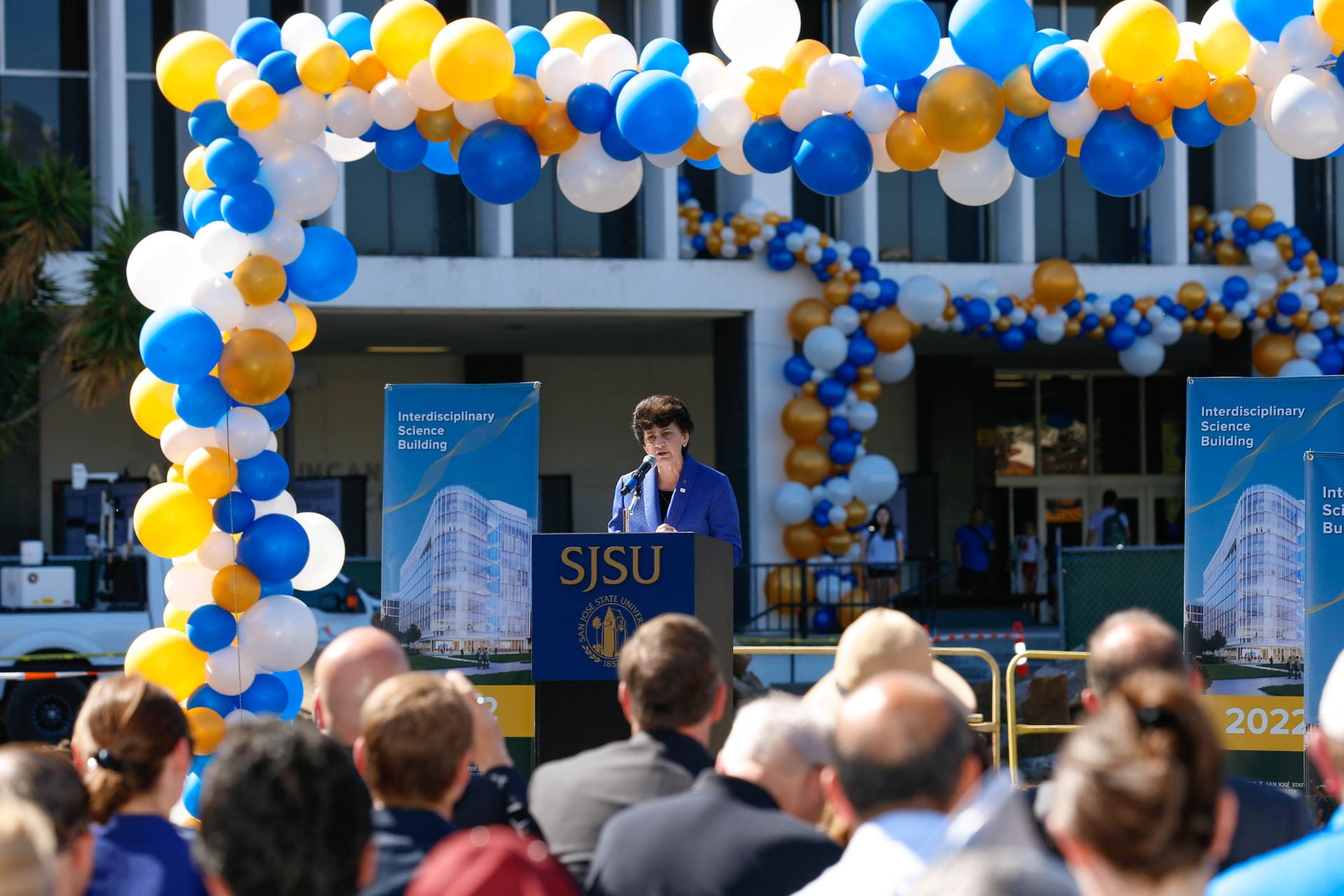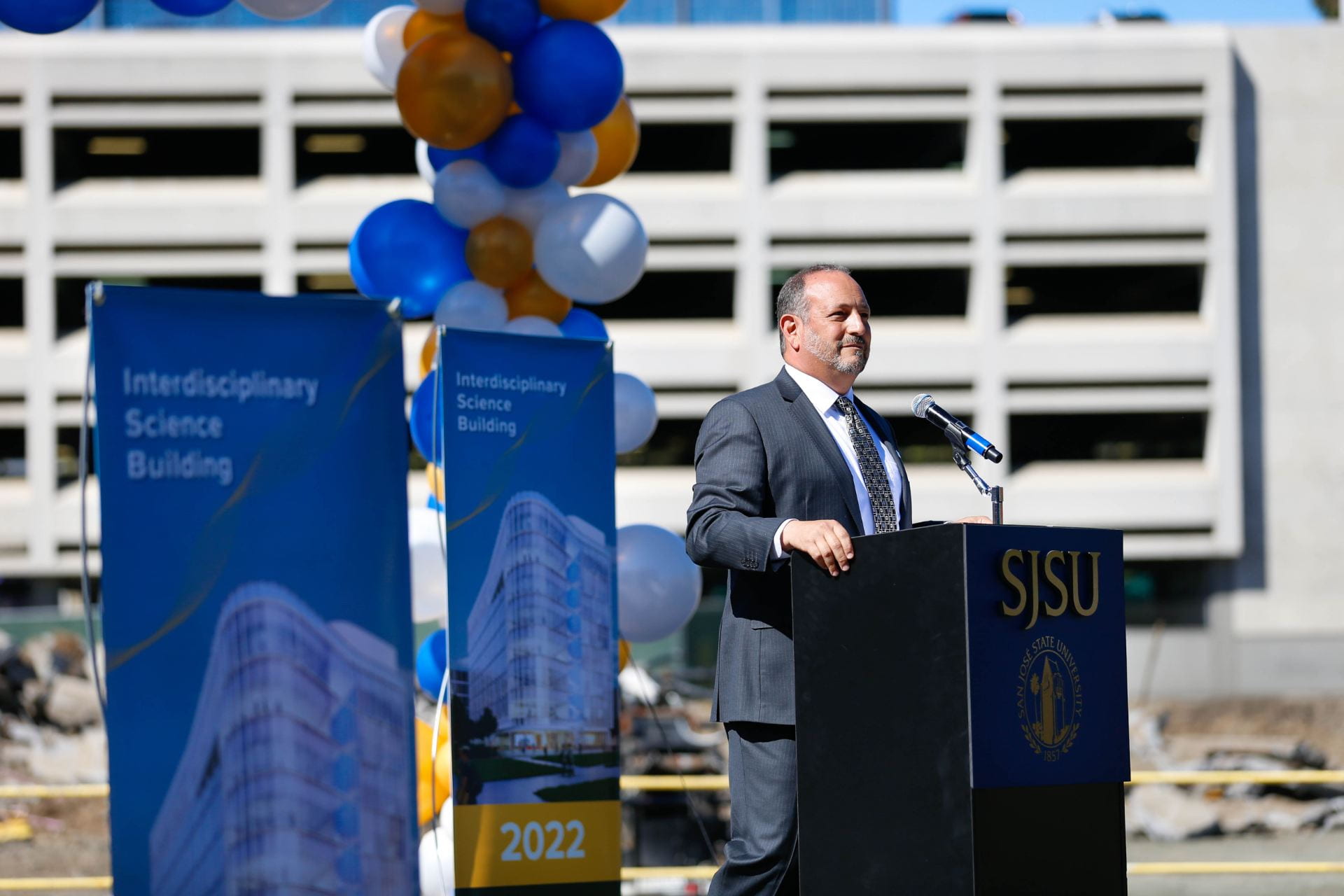
SJSU celebrated the historic groundbreaking for the Interdisciplinary Science Building April 25. Photo by Josie Lepe

SJSU President Mary A. Papazian speaks about the vision for a Science Park during the groundbreaking. (Photo by Josie Lepe)
San Jose State University celebrated the historic groundbreaking of a new Interdisciplinary Science Building (ISB) today – the first new academic building in more than 30 years and the first new science facility in nearly 50 years – with hundreds of people turning up for the event. The building is the first phase of a planned Science Park that will push the boundaries of the traditional science education model that will make teaching, research and collaboration inseparable.
“The breadth of discovery and research in the Interdisciplinary Science Building will be astonishing,” said SJSU President Mary A. Papazian. “The College of Science will rightly take its place among the most modern and innovative science colleges in the Bay Area, and indeed, the country.”
During the ceremonial groundbreaking, Papazian said the ISB will be both functional and symbolic.
“It will symbolize our growing bond and ongoing synergies with Silicon Valley and the tech industry,” she said. “It will symbolize our connection to the City of San Jose and to the entire region. It will symbolize who we are and what we want to be known for at San Jose State University.”

Michael Kaufman, the dean of the College of Science, shares how the new building will integrate teaching, research and collaboration. (Photo by Josie Lepe)
In his remarks, College of Science Michael Kaufman described the three existing buildings that house departments from the College of Science as having “163 years of experience” – the Science building, which opened in 1957, MacQuarrie Hall which opened in 1965 and Duncan Hall, which was completed in 1972.
“When these were built, classrooms were designed to be faculty-centric and static,” he said. “There were few spaces for students to interact outside of a traditional classroom, and research space was largely an afterthought.”
The eight-story, $181 million ISB, which will be funded using California State University systemwide revenue bonds, will house chemistry and biology teaching and research lab spaces, an interdisciplinary Center for High Performance Computing and a data and science information lab for the College of Professional and Global Education. Adjoining research labs the building will have “collaboratories” that recapture hallway spaces to allow student research teams to gather away from instrument setups and chemicals to present and discuss results. In addition, the building will have collaborative hubs on every floor for students and faculty to work together.
“Research is a fundamental part of higher education, but as my fellow scholars know well, its value extends beyond new knowledge,” Kaufman said. “When involved in research, our students build practical skills and work to solve some of our biggest disciplinary and interdisciplinary problems.”
The College of Science serves 3,000 undergraduate and graduate students in the disciplines of biology, chemistry, computer science, geology, mathematics and statistics, marine science, meteorology and climate science, physics and astronomy, and science education. Of the student population, 45 percent are women, and 1 in 5 are from traditionally underrepresented groups.
“By engaging in hands-on research, we provide students with the opportunity to move beyond theory, develop collective ideas in the classroom, and apply it to open-ended problems that push the frontiers of their fields and help solve societal problems,” he said.
Krista Wirth,’ 17 biological sciences, minor in chemistry, who is now a lecturer in the College of Science and served on the ISV advisory team as a student representative, shared a student’s perspective.

Krista Wirth, ’17 biological sciences, minor in chemistry, who is now a lecturer at SJSU, shares some remarks during the groundbreaking April 25. (Photo by Josie Lepe)
“I joined the building planning committee because my experience as a student at SJSU in science paved the way for my future,” she said. “I joined the Spartan community as a first-generation college student, and I had no idea what I wanted to do with my life or how to do it.”
Her experience with scientific research with Associate Professor of biology Shelley Cargill empowered her in discovering her interests and in shaping her ambitions.
Wirth served on the advisory team with graduate student Anthony Balistreri, who has since graduated and gone onto a PhD program at the University of Michigan. They advocated for research and collaboration, and sustainable and environmentally-friendly design.
“It was important to us to include student-centered collaboration spaces—spaces where students could study, exchange ideas, find inspiration, and use science to tackle all sorts of issues,” Wirth said. “We wanted state-of-the-art learning spaces that would empower Spartans with knowledge and skills to support their success here at SJSU and in their journeys thereafter.
At the event, representatives from the offices of Assemblymember Evan Low, an SJSU alumnus, Assemblymember Ash Kalra and Congressmember Zoe Lofgren presented Papazian and Kaufman with congratulatory resolutions.
